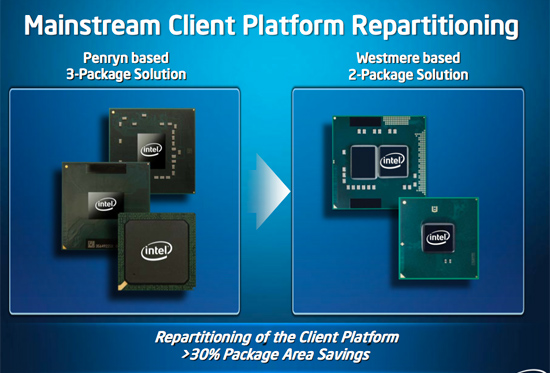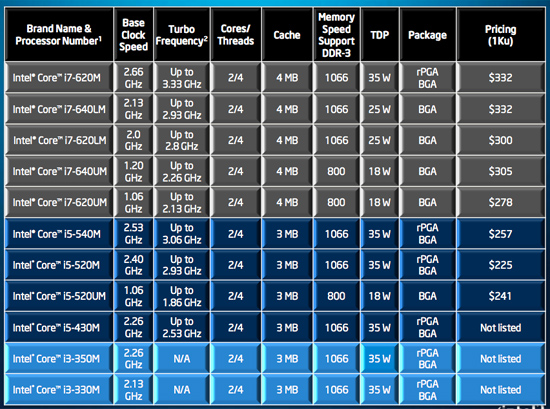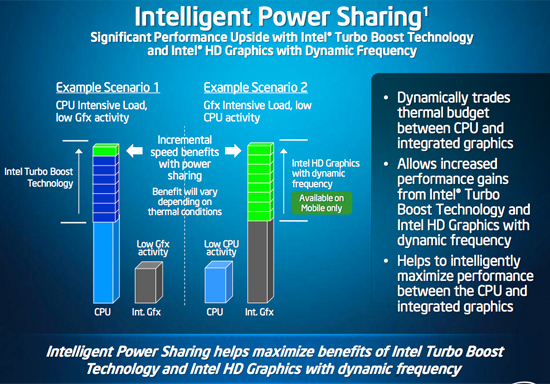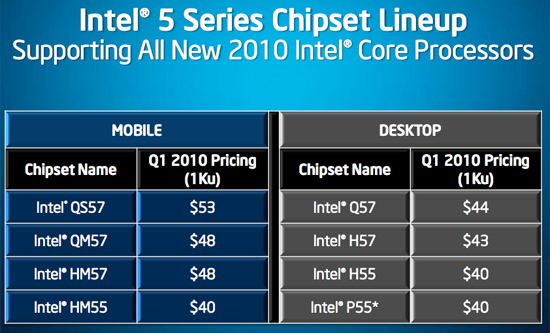Intel Arrandale: 32nm for Notebooks, Core i5 540M Reviewed
by Anand Lal Shimpi on January 4, 2010 12:00 AM EST- Posted in
- Laptops
Clarkdale is the desktop processor, but Arrandale is strictly for my notebooks. The architecture is the same as Clarkdale. You've got a 32nm Westmere core and a 45nm chipset on the same package:

The two-chip solution does matter more for notebooks as it means that motherboards can shrink. Previously this feature was only available to OEMs who went with NVIDIA's ION platform (or GeForce 9400M as it was once known). This is the first incarnation of Intel's 32nm process so it's not quite as power optimized as we'd like. The first mainstream Arrandale CPUs are 35W TDP, compared to the 25W TDP of most thin and light notebooks based on mobile Core 2. Granted the 35W includes the graphics, but it's not always going to be lower total power consumption (more on this later).
The Arrandale lineup launching today is huge. Intel launched 7 Clarkdale CPUs, but we've got a 11 mobile Arrandale CPUs coming out today:

The architecture is similar to Clarkdale. You get private 256KB L2s (one per core) and a unified L3 cache for the CPU. The L3 is only 3MB (like the Pentium G9650) on the Core i5 and Core i3 processors, but it's 4MB (like the desktop Core i5/i3) on the mobile Core i7. Confused yet? I'll have to admit, Intel somehow took a potentially simple naming scheme and made it unnecessarily complex. We also get some low-voltage parts that have 18W TDPs. They run at low default clock speeds but can turbo up pretty high.
Turbo is hugely important here. While Clarkdale's Turbo isn't exactly useful, the TDPs are low enough in mobile that you can really ramp up clock speed if you aren't limited by cooling. Presumably this will allow you to have ultra high performance plugged-in modes where your CPU (and fans) can ramp up as high as possible to get great performance out of your notebook. Add an SSD and the difference between a desktop and a notebook just got even smaller.
Arrandale does have one trick that Clarkdale does not: graphics turbo.

GPU bound applications (e.g. games) can force the CPU part of Arrandale into a low power state, and the GPU can use the added thermal headroom to increase its clock speed. This is a mobile only feature but it's the start of what will ultimately be the answer to achieving a balanced system. Just gotta get those Larrabee cores on-die...
Chipsets are even more complicated on the mobile side:












38 Comments
View All Comments
MonkeyPaw - Monday, January 4, 2010 - link
Personally, I'm disappointed with the "unchanged" battery life. The reality is, most IGP-based notebooks don't need to be faster to most people. A few friends of mine recently bought notebooks, and they have what I call average requirements: email, browser, iTunes, office, photo management. My advice to them was that anything they buy today will be more than fast enough for their needs (they were currently running outdated machines), and that their decision should be based on things like battery life and bonus features. Even my own notebook purchase was based less on total processing power and more on price, then battery life.I think Intel had it backwards. Start by improving battery life, then slowly improve performance. That may have been their plan, but it looks like 32nm has a ways to go for them before that can happen.
JarredWalton - Monday, January 4, 2010 - link
I would expect the LV versions to be competitive, but it wouldn't surprise me if the initial 32nm parts are not where they would like in terms of power use. The rev 2 of Arrandale will hopefully address that shortcoming.secretanchitman - Monday, January 4, 2010 - link
thats the thing though - who knows what apple is going to do now, since they currently use ion/9400m in the macbooks/macbook pros. they do use intel + discrete ati in the current imacs, yet the lowest end imac has a 9400 in it. the problem with arrandale is that it has the gpu integrated on, and traditionally...intel integrated graphics suck compared to nvidia and ati gpus.im hoping that intel made special versions of arrandale without the built in gpu, or they are able to turn it off, and use separate graphics instead. lets be honest, the 9400m is much better than anything intel offers now.
taltamir - Thursday, February 4, 2010 - link
what does it matter? apple can't run games anyways... neither can any laptop.The difference between intel and nvidia/ati is that a laptop with nvidia/ati can get playable FPS on the absolute LOWEST settings which look like crap. the intel can NOT get playable FPS, period.
Either would be a horrid experience for a gamer... get a desktop if you want to game.
filotti - Tuesday, January 5, 2010 - link
Actually, the article says that the performance of the integrated GPU is equal to the performance of the 790GX IGP. This means that it should be equivalent to the 9400m too.mino - Saturday, January 9, 2010 - link
Raw performance? Probably comparable to 785G in 3D benchmarketing.Drivers to be able to use the performance. Non existent.
This is pretty much a beefed up HD4500. Nothing less, nothing more.
marc1000 - Monday, January 4, 2010 - link
The desktop versions have a 16xPCIe slot, so I believe it IS possible to pair the mobile versions with discrete grapchis too. Not that manufacturers will be that much interested in doing so. After all, it seems that Intel aimed for the same level of performance that 9400 has, so Apple would not have reasons to go "non-Intel". I guess this is the primary reason why they made the GPU perform exactly at this level. It's the "good enough" philosophy.Penti - Tuesday, January 5, 2010 - link
Of course you can, HM/QM/QS57 supports switchable graphics too and has x16 or the same 16 (maybe) lanes on-die as the desktop parts for discrete graphics. It also has 8 lanes on the chipset. Apple, HP, Dell, Fujitsu etc will be interested in more high-end business models and consumer products.